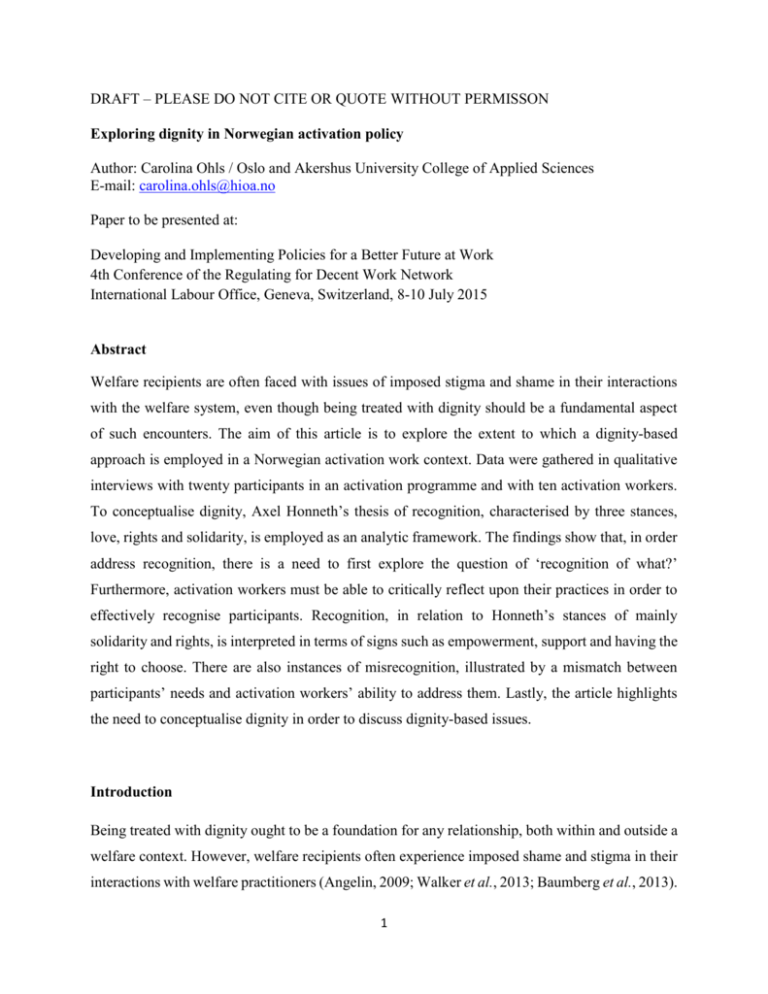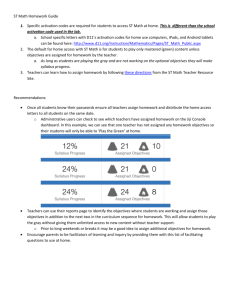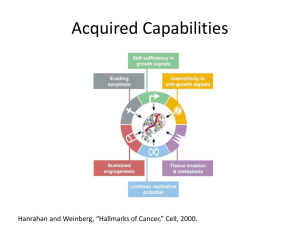full paper - Conference of the Regulating for Decent Work Network
advertisement

DRAFT – PLEASE DO NOT CITE OR QUOTE WITHOUT PERMISSON Exploring dignity in Norwegian activation policy Author: Carolina Ohls / Oslo and Akershus University College of Applied Sciences E-mail: carolina.ohls@hioa.no Paper to be presented at: Developing and Implementing Policies for a Better Future at Work 4th Conference of the Regulating for Decent Work Network International Labour Office, Geneva, Switzerland, 8-10 July 2015 Abstract Welfare recipients are often faced with issues of imposed stigma and shame in their interactions with the welfare system, even though being treated with dignity should be a fundamental aspect of such encounters. The aim of this article is to explore the extent to which a dignity-based approach is employed in a Norwegian activation work context. Data were gathered in qualitative interviews with twenty participants in an activation programme and with ten activation workers. To conceptualise dignity, Axel Honneth’s thesis of recognition, characterised by three stances, love, rights and solidarity, is employed as an analytic framework. The findings show that, in order address recognition, there is a need to first explore the question of ‘recognition of what?’ Furthermore, activation workers must be able to critically reflect upon their practices in order to effectively recognise participants. Recognition, in relation to Honneth’s stances of mainly solidarity and rights, is interpreted in terms of signs such as empowerment, support and having the right to choose. There are also instances of misrecognition, illustrated by a mismatch between participants’ needs and activation workers’ ability to address them. Lastly, the article highlights the need to conceptualise dignity in order to discuss dignity-based issues. Introduction Being treated with dignity ought to be a foundation for any relationship, both within and outside a welfare context. However, welfare recipients often experience imposed shame and stigma in their interactions with welfare practitioners (Angelin, 2009; Walker et al., 2013; Baumberg et al., 2013). 1 For welfare recipients, shaming has also negative consequences for their wellbeing, as well as shaming reduces individual agency (Lister, 2004; Walker, 2014). In order to avoid issues of shaming and stigma, previous research (Gubrium & Lødemel, 2014; Walker, 2014) has advocated a dignity-based approach towards welfare recipients. In this context, a dignity-based approach is believed to enhance individual agency. To enable a discussion of a dignity-based approach, there is a need for defining the concept of dignity. Sawyer (2011) argues that ‘dignity’ is a vague term, pointing out that: ‘To be told that dignity is “worthiness” or “that which is worthy of respect” is of little help, though it is easier to recognize instances of dignity being threatened or denied’ (2011, p. 191). Others, such as Misztal (2012), points out that the principle of dignity holds a universal value, garnering increased interest not only as a key legal notion but also as a fundamental aspect of democratic society. Nussbaum (2006, 2011), on the other hand, links dignity to the enhancement of capabilities and legal rights. For the purpose of this study, to analyse the extent to which a dignity-based approach is employed within Norwegian activation work, Honneth’s (1995) thesis of recognition has been applied as a conceptualization of dignity. For Honneth, an enhancement of self-esteem is especially connected to strengthen dignity. Furthermore, recognition builds on a relational aspect between individuals and/or institutions, which aim at enhancing self-confidence, self-respect and self-esteem (Honneth, 2007). In a framework of activation work, the relational emphasis is important for establishing a relationship, which aims at enhancing recognition, embodied morally and ethically in the practice. Data to explore the research question, ‘To what extent is a dignity-based approach employed in an activation work context?’ are based on perceptions of both activation workers and participants in a Norwegian activation programme. While there is a vast literature on activation, some scholars argue that relatively little is known about the role activation workers play in implementing and delivering activation services (see for example van Berkel & van der Aa, 2012). Other scholars argue that users’ perceptions are often overlooked when discussing activation workers’ practices (Wright, 2013; Marston, 2013). Against this background, the aim of the study is: (1) to gain a deeper understanding of what characterises a dignity-based approach; (2) to add to our understanding concerning activation workers’ roles in delivering of services; (3) to include the voices of users in a discussion of practices. 2 Defining recognition Honneth’s (1995) thesis of recognition is inspired by Hegel, who claims that the philosophical theory of society must proceed not from individual actions, but from a framework of ethical bonds. The element of ethical bonds informs the theory of recognition. Honneth highlights that there are two different ways to understand recognition: either as an attributive or a receptive act. Both concern a cognitive relation between the persons involved. In the first case, recognition contains an attribution through ascribing to the person a new, positive quality. In the second case, recognition is understood as a perception, meaning that qualities the person already possesses are strengthened or manifested publicly. Furthermore, Honneth points out that that recognition is not only granted by individuals, but also by social institutions. Patterns of recognition can first be established as rules and practices within an institution, before they are carried out as actual praxis. In his deliberations over recognition, Honneth (2007) calls for a ‘restriction of egocentrism’, referring to actions that do not violate our self-love. He claims that ‘…to recognize someone is to perceive in his or her person a value quality that motivates us intrinsically to no longer behave egocentrically, but rather in accordance with the intentions, desires, and needs of that person’ (2007, p. 337). Honneth reaches the conclusion that we need to distinguish between three sources of morality corresponding to the various forms of recognition behaviour. These forms of moralities are love, legal respect and social esteem. The three forms reflect upon ‘the value of horizon of modern societies’ (2007, p. 337) where humans are equally entitled to autonomy and equally capable of achievement. Another way to capture the essence of Honneth’s thesis on recognition is to focus on the concepts of basic self-confidence, self-respect and self-esteem, which according to Brink and Owen (2007) form the three axes of recognition. Self-confidence relates initially to the relationship between mother and child, and Honneth describes this relationship as ‘conceptually and genetically prior to every other form of recognition’ (1995, p. 107). The recognition of self-confidence is an ongoing activity continuously carried out between parents, friends etc., whereas legal recognition, labelled as self-respect, enables a person to exercise her rights and stand up for herself in public debates. A struggle for respect/recognition is marked by a generalisation and /or de-formalisation of rights 3 (Brink & Owen, 2007). Honneth means by self-esteem a practical relation-to-self in which one’s abilities and traits are valued. He argues, ‘Relationships of this sort can be said to be cases of “solidarity” because they inspire not just passive tolerance but felt concern for what is individual and particular about that person’ (1995, p. 136). In terms of criticism towards Honneth’s axes of recognition, Brink and Owen (2007) point out that there may be more or fewer axes of recognition than those Honneth initially identifies. Also, they find that Honneth’s specification and strict demarcation may create blind spots in terms of neglecting power struggles. Furthermore, Brink and Owen imply that there is an element of unawareness within Honneth’s thesis in that it overlooks structural injustice ascribed to, for example, forms of ethno-centrism and social patterns of expectation and normative evaluation common in Western societies. Garret (2010), on the other hand, criticises Honneth’s thesis for psychological reductionism when it stresses the importance of a well-developed bond between mother and child in order for the child to become a confident individual. Garret points out that people lacking in confidence may still be able to provide esteem and recognition to others. Within activation work, the criticism may play out in terms of a top-down approach between activation workers and participants, and there may also be a normative approach found within the structure and/or delivery of activation work. Situated ‘misrecognition’ may also impose shame and stigma on participants. In the discussion section these issues of recognition will be further explored. The next section briefly describes the QP and how participants experience the programme. Earlier studies investigating activation workers’ attitudes in a Norwegian and European context are also presented. Research context – participants’ experiences and activation workers’ approaches The Norwegian activation work programme, The Qualification Programme [QP] is a point of departure for studying to what extent a dignity based approach is employed in a Norwegian context. The QP was introduced in 2007 and is designed for long-term recipients of social assistance, with the aim of enhancing participants’ abilities to find employment (Ministry of labour and social affairs, 2014). It is a one-year programme, with the possibility for a 12-month extension. While participants are enrolled in the programme, they are entitled to a qualification benefit (NAV, 2014). Furthermore, QP has been described as a successful programme (Duffy, 2010). Other studies on the QP showed, among other things, that participants felt empowered by their 4 participation in the programme; they found the programme meaningful and, especially participants with a minority background, found that it enhanced their employment possibilities as they gained work training and improved their Norwegian language skills (Reichborn-Kjennerud, 2009; Schafft & Spjelkavik, 2011; Djuve, 2012). On the other hand, there are also contradictory findings showing that QP participants experienced feelings of being ‘exploited’ after ‘working for free’ within the programme (Gubrium & Lødemel, 2014, p. 98). Focusing on QP activation workers, in a national evaluation, when activation workers were asked to assess their capabilities, the ones they most appreciated were social work and related professional work skills and interpersonal skills focusing on enhancing user involvement. QP activation workers also felt that they were fairly effective in assessing participants’ employability and work possibilities. Skills related to labour market issues were scored lowest (Schafft & Spjelkavik, 2011). Although professional and interpersonal skills seem to be evaluated highly, a study conducted by the Board of Health Supervision (2015) demonstrated gaps in the actual delivery of services. For example, employability assessment was often lacking or was poorly conducted. Individualised activation plans, considered a key element for successful participation, were often not thoroughly followed up on. Moreover, the focus on user involvement was not successfully maintained. The two presented studies show that there is a lack of coherence between how activation workers assess their own skills and how the actual work is implemented. However, Schafft and Spjelkavik (2011) as well as the study from the Board of Health Supervision (2015) found that there are local variations in the delivery of activation services, which may affect the quality of the services. In cases of poorly delivered services, it is largely the participants that suffer most, which holds negative implications for the activation process. Activation workers’ perceptions are also highlighted in different European studies (Fletcher, 2011; Raeymerckers & Dierckx, 2013; Dunn, 2013). Raeymerckers and Dierckx (2013) analysed ways social workers perceive and define activation in Belgium. They found that social workers who had adopted an empowerment perspective of activation defined activation work in terms of a more tailor-made approach that also aimed at enhancing clients’ dignity. In contrast to the empowerment approach, findings also indicated a disciplinary approach to activation. The main emphasis in this approach is on attaining employment rather than enhancing the overall life situation of the clients. 5 Fletcher’s (2011) qualitative study on English activation workers showed that discretion was a main feature of their work. Some activation workers emphasised providing enhanced services for their clients, while others held a policing attitude. Policing attitudes, or normative ones, were also found in another English study, conducted by Dunn (2013). Dunn investigated activation workers’ views about their clients’ work attitudes and job search behaviour. He found that the activation workers believed that their clients were ‘choosy’ about their jobs and that they held ‘unrealistic expectations’ (2013, p. 813). Furthermore, Dunn found that a large majority of the forty activation workers interviewed supported the idea that a ‘dependency culture’ existed among some of their clients. The following sections outline the methodological framework and the result from exploring the extent to which a dignity-based approach is employed within Norwegian activation work, based on the perceptions of QP participants and the activation workers. When conceptualising activation workers, other references include ‘frontline workers’, ‘street-level bureaucrats’ (Lipsky, 1980) and ‘agents of welfare’ (Jewell, 2007). In this following discussion the term ‘activation worker’ refers to a service provider who is involved in the delivery of activation services. Methods Data collection The study builds on two sources: semi-structured qualitative interviews conducted with twenty QP participants (n=20) and ten activation workers (n=10). Data were collected by the author at a publicly funded activation centre in Oslo. The main recruitment criteria for participating in the interviews were that the activation workers were working with QP activities and that they were in frequent contact with the QP participants. The requirement for QP participants was that they were taking part in QP activities offered by the centre. The majority of the QP participants, seventeen out of twenty, were recruited by activation workers at the centre, and the remaining three were recruited directly by the researcher. Due to practical reasons, two of the interviews with participants were conducted outside the centre, while the rest were conducted at the centre. The interviews with QP participants were conducted in Norwegian and most lasted about 60 minutes, although some were shorter due to language issues. QP 6 participants received compensation in the form of a gift card of 100 NOK (approximately £9) for participating in the interview. The researcher recruited activation workers for interviews about four months after completing most of the interviews with the QP participants. All interviews with activation workers were conducted at the centre, either in their office or in a meeting room. The interviews with activation workers lasted approximately 60–80 minutes and they were conducted in Norwegian. All of the interviews, both with participants and activation workers, were recorded and transcribed by the researcher. Limitations The majority of the QP participants were recruited by activation workers at the centre. Due to established contacts between QP participants and activation workers, the activation workers may have recruited QP participants that they favour. During the interviews with participants there were also some language issues, as some of the participants had limited Norwegian language skills. In hindsight, an interpreter should have been used in those cases where language issues arose. Except for interviews with two of the participants, all of the interviews (both with activation workers and participants) were conducted at the centre due to convenience. The location could have influenced the discussions by hindering people from speaking freely about their experiences. Analysis The qualitative interviews have been analysed by conducting an interpretative phenomenological analysis (IPA). IPA is employed especially in qualitative health and psychological studies (Biggerstaff & Thompson, 2008). IPA explores personal experiences, based on the individual’s perceptions or accounts of object or events that ascribe meaning to those experiences. (Smith & Osborn, 2007; Biggerstaff & Thompson, 2008). In this case participants’ and activation workers’ experiences and perceptions are a point of departure for exploring a dignity-based approach. The analysis of the qualitative interviews was started by reading through the verbatim transcripts, followed by using the qualitative software program Atlas.ti to code data. The coded data differ depending on data sets; examples of codes for interviews conducted with activation workers are (1) staff attitudes, (2) collaboration with others and (3) work challenges. The codes for participants 7 focus on activation-course-related aspects, such as work placement, and other issues such as previous welfare experiences and health-related problems. Findings of the study Overview of data Ten activation workers, seven female and three male, were interviewed. Eight of the ten workers hold university degrees within social sciences and arts. Two activation workers are skilled social workers. The average length of time working at the research site was six years, though with variations – some had been working there for nearly 15 years while one activation worker was newly employed. In addition to interviews with activation workers, data built on interviews with twenty QP participants; thirteen female and seven male participants were interviewed. Nine women and four men had a minority background, having been born in countries in Africa, the Middle East, South Asia and Latin America. Most of the participants with a minority background had been in Norway for less than seven years. Seven of the respondents were ethnic Norwegians. Most of the QP participants had been involved with QP activities for the past 6–12 months at the time they were interviewed. In table 1 the main characteristics of respondents, activation workers and QP participants are outlined. Table 1. Main characteristics of respondents. Background Minority background - Female - Male Majority background - Female - Male Education above - secondary level - university level Average age Average time spent at research site Activation workers (n=10) QP participants (n=20) 0 1 9 4 7 2 4 3 1 (female: 1, male: 0) 9 (female:6, male: 3) 48 years 9 (female: 6, male: 3) 7 (female: 3, male: 4) 42 years 6 years 6-12 months 8 Participants’ background The twenty participants who were interviewed had in common their aim of finding paid employment. For participants with a minority background, there was an additional aim of increasing their level of Norwegian language skills. However, participants struggled with finding work for different reasons, such as limited Norwegian language skills, insufficient work experience and low education. Furthermore, some participants had financial issues. Other challenges, such as mental and physical health issues, were also mentioned in the interviews. Being unemployed was also linked to feelings of inadequacy. One of the participants, Alice, referred to shame when describing her situation: It is may be that (shame) which makes it take such a long time finding work. That is shame. It is uncomfortable also embarrassing, talking about it… Thinking about my network, the one I had in the USA, that feels shameful. I do not want to tell them that I am out of work. All of them are CEOs in different places, right? // I have been in touch with a couple of them on LinkedIn. Until recently, I have not been saying that I am out of work. It is somewhat shallow what we are writing to each other, right? They ask, ‘What do you do?’ I was employed before, it still says there (on LinkedIn), and you do not write back that you are unemployed. As shown, Alice believed that feelings of shame held her back from exploring opportunities. Eventually, shame may also have been a reason for her unwillingness to mention her situation to her acquaintances. For other participants, previous experiences from different welfare initiatives held negative connotations. Monika shared the following experience from a previous activation course she had taken part in: Erm… because at the other place (another activation course) they were more passive. Still, they were stressed out about finding us work placements because NAV (national welfare office) pushed for that. My opinion is that you cannot participate in work placement at any price. That is… Are you not supposed to get something out of it as well? To sum up the participants’ point of departure, the aim of participating was to find employment and to increase the level of Norwegian language skills. As shown, there were also challenges and 9 external circumstances which affected their situation. Furthermore, previous experiences may also have affected how participants perceived their current activities and how they were approached by activation workers. In the discussion section this will be further elaborated. Next, the focus is on exploring the extent to which a dignity-based approach is employed in an activation work, based on the perspective of participants and activation workers. Exploring recognition and misrecognition The concepts of recognition and misrecognition have been applied as an analytic framework for understanding dignity. In table 2, the findings are summarised to identify themes of recognition and misrecognition. In the following sections these themes will be illustrated with extracts from the interviews with participants and activation workers. Participants’ accounts of recognition and misrecognition were mostly based on their interactions with activation workers. Activation workers’ accounts of recognition and misrecognition highlight examples where they have acknowledged or neglected situations participants’ or circumstances. Occasionally recognition/misrecognition has taken place on a structural level. The findings will be further discussed in the last section. Table 2. Themes of recognition and misrecognition PARTICIPANTS ACTIVATION WORKERS RECOGNITION Right to choose Empowerment Treated with respect Critical reflection – a premise for recognition Understanding approach Supportive Tailor-made solutions STRUCTURAL LEVEL Enhance agency Openness MISRECOGNITION Pushed to accept offers Ignoring needs Belittling attitudes Avoid reflection Pushing own agenda Disfavour / Normative Standardised approach Hinder agency Discrimination Participants’ accounts of recognition and misrecognition 10 First, having the freedom to choose will be explored. For three female participants, having the possibility to choose held a significant meaning. One of the participants, Ingrid, pointed out that earlier in her life she used to accept all kinds of work offers. This made her feel used and she had ended up in bad working conditions. Her new activation workers stressed that she had the opportunity to choose for herself and she had the right to decline offers that did not match her wishes. Having the freedom to decline offers was an empowering feeling for Ingrid. Another participant, Amina, framed her abilities to choose as follows: I can think for myself – What is best for me? For my health? For my emotional well-being? Amina also mentioned that the activation workers acknowledged her choices, and they did not push her into activities she was not interested in; for example, they did not require her to take a work placement in a place that did not appeal to her. Alice shared a similar experience of being acknowledged for her ability to choose for herself. She had had somewhat negative experiences in previous activation courses and was not keen on joining the activation centre. She described her expectations and experience accordingly: Am I supposed to participate in a course, and be told that I have to keep trying? Of course I know I have to keep trying. Now, it has not been like that here. And that is good. Anne, on the other hand, showed an example of being empowered, when activation workers had acknowledged difficulties and slowed down the process. She explained: Anne: They started to push somewhat. And I could feel that I resisted that, and they understood at once that… there was something… But I have been honest all the time. I do not know, maybe that impacted on the result as well. I: What did they push? Anne: I do not know really… It was more like, what can we do for you…? We need to find a work placement for you. And I became… Because my self-confidence was next to nothing… It was down to minus ten, right? (Laughter). Therefore, they realised that they needed to do something before they could find me a work placement. Anne pointed out that in her intake meeting she had stated that she was ready for anything, but it became apparent as she started the process that she was not feeling ready to go out into the labour market. As she highlighted, she struggled with very poor self-confidence. Her activation workers helped her to work on her self-confidence issues by supporting her and letting her steer the process. At the same time, Anne felt that ‘They believed in me all the time.’ For Anne, it was fundamental for her well-being, and the activation workers’ support made her appreciate their efforts. 11 The majority of the participants talked mostly positively about their experiences at the activation centre. For example, activation workers at the centre were described as ‘kind’ and ‘supportive’. Some participants also highlighted how their confidence increased as the programme opened up new opportunities. Eric described his experiences accordingly: It is better here (compared to another activation centre) because you have somebody walking by your side. Someone who helps you to look for work and prepare for interviews. However, these examples in which recognition took place were juxtaposed with events of misrecognition. A cause of misrecognition was found in a mismatch between participants’ and activation workers’ perceptions of what constituted ‘good practice’. Activation workers may have acted with good intentions while the participants felt the opposite. One of the male participants, Sven, illustrated such an event: Sven: Although she was a keen listener, she was caring, I think we were just talking without achieving much. I: You wanted something else…? Sven: I did not want that much, actually. I did not have much of my own will. For example, I wanted to get rid of my debt, which I owed the state. // It was that (the debt) that made me feel depressed at times. I: So there is another issue here… You have a debt, which makes you feel bad about yourself. Sven: Very much so, a lot of my issues are linked to that. Sven’s activation worker was described as thoughtful. However, the thoughtfulness did not satisfy Sven’s needs, as he was more concerned about sorting out his debt than about participating in the activation activities. He found that he and his activation worker did not ‘achieve much’ and his needs were not recognised. Another participant, Monika, also shared an event, which highlighted a mismatch between her activation worker’s good intensions, and Monika’s actual preferences. Her story related to finding a work placement. She had visited a shopping centre together with an activation worker, and the activation worker had asked in different shops about the possibility of Monika undertaking a work placement there. This is how Monika felt about the situation: But I did not want to walk around the whole shopping centre and announce myself in that way. If you understand what I mean? // Because I find it a bit belittling. 12 Monika showed she was not comfortable with the situation and how the search for a suitable work placement was being carried out. She explained later on that she would have preferred that the activation worker had investigated the possibilities without Monika being present. In comparison to the earlier case, where the activation worker was accused of not achieving much, this particular case showed the opposite; the activation worker had been too proactive and was overriding Monika’s preferences. A third participant, Anders, felt that he was placed in a box due to his professional background and he was not given an opportunity to look for other options. Anders found that some of the offered activities were ‘…wasted. That course is best suited to people who do not know what they want.’ His disappointment could have been avoided if his activation worker had been able to discern and acknowledge his needs instead of offering him standardised solutions based on his professional background. Lastly, work placement was a common activation offer for the participants. However, work placement also became a source of frustration and misrecognition, as it did not fulfil the conditions of paid employment. Some participants felt trapped; for example, Aisha, expressed her disappointment by asking herself, ‘Am I supposed to spend my whole life on work placement?’ Other examples of misrecognition were found in issues related to discrimination in the labour market. Two female participants felt that their minority background was used against them in employment situations, and the discrimination strongly violated their sense of being recognised. Next, the focus turns to the activation workers. Activation workers’ accounts of recognition and misrecognition Throughout the interviews with activation workers, an overriding theme was their ability to critically reflect upon their own practice as well as their own prejudices. Although self-reflection did not necessarily mean that recognition was achieved, it may have been perceived as a first premise for enabling recognition. One of the female activation workers, Anne, gave the following example: My opinion is that we make so many assumptions in this business. We assume things so quickly. I have been wrong so many times, based on a first impression after meeting participants. I have been wrong. Those I believed were the most resourceful may be the ones who needed the most 13 support, and those who seemed less resource—... ‘resourceful’ is the wrong word here, but say ‘not ready for work’, they managed to become employed. Anne showed that by reflecting on her own presumptions, she was able to acknowledge them and come to realise that she had been mistaken at times. The complexity of challenging one’s presumptions was also illustrated in the interview with Katrine, an activation worker who shared the following reflections in a discussion of Somali female participants’ clothing preferences: Katrine: // How do I communicate and build trust, without thinking ‘oh my god’? We need to build communication skills. I: And it takes time to build a relationship, where they can trust you and know that you want their best, without/ Katrine: / me pushing them. // I need to reflect on my own practice because sometimes I notice, ‘my lord, that is exactly what I want to do’ (push them). Right? I need to challenge myself. I need to watch myself. And my own motives, because of my issue with this. Sometimes it is easy for me to just take a shortcut and say, ‘Damn it, I cannot keep trying with her. She has to understand where she is. [She has to] put on those trousers if she wants to become employed, or she finds herself a Muslim country.’ And sometimes it may be ok to say that. While other times it is just my own tiredness speaking. I need to find the balance, right? Katrine was honest with herself about the issues she was struggling with in terms of Somali female participants’ clothing preferences. She realised that at times it was just her tiredness speaking, which showed that she was able to reflect upon her own practices. At the same time, the signs of tiredness also showed that there were underlying presumptions, which indicated misrecognition. Furthermore, a number of activation workers had gone through difficult periods themselves in life, and they reflected upon this in relationships with participants. Another activation worker, Per, explained: ‘I recognise some of the same issues. I really do. Some of them have really hit the wall. // I think it is ok to acknowledge that you have been… Erm… I have gone through some health issues myself.’ By acknowledging and reflecting upon the issues he had gone through himself, Per was able to understand the participants’ circumstances from a viewpoint of empathy. Furthermore, some of the activation workers worked only with participants with a minority background, because the activation centre had tailored activation activities to suit their specific target group. The tailor-made services, which focused particularly on enhancing language skills through group activities and work placements, were in themselves a way of recognising 14 participants’ needs. The local welfare office also supported these kinds of tailor-made services. A practical example of tailor-made solutions was giving a list of work-related words to nonNorwegian speaking participants involved in work placement. Activation workers also paid frequent visits at the beginning of a period of work placement to follow up on their participants’ progress. Participants were also encouraged to find work placements themselves, but if they did not succeed, the activation workers helped them. Despite the support and tailor-made services, there were issues, according to the activation workers. Mano gave an example showing how he tried to support his participant and, as well, how his willingness to be supportive became counterproductive: I believed in him. He did not manage to find a work placement on his own, but I found a place for him, where he began. And he was there for two months. But I sensed that something was wrong there. I invited him to a trialogue with the welfare office to discuss my concern. And in the meeting this elderly man started to cry. I asked him, ‘What has happened?’ He replied that he did not like his work placement. It was dreadful for him. I told him, ‘But I visited you, every day, and every second day, why did you not tell me?’ He answered, ‘Because you were the one who found the work placement for me.’ He tried to satisfy me instead of himself. And from that moment, I stopped looking for work placements on behalf of the participants. We do it together. You try first, and we help and guide you. But it is your life, your process. // I can guide you and offer advice. But you are making the choices. // They need to own the process; until now, there were others who owned their process and development. They have only been marionettes, moving in the direction that the society or these welfare institutions want them to go. As Mano claimed, without ownership, the participants will end up as ‘marionettes’, pleasing other people and going where others want them to go. However, being supported in finding a work placement may not necessarily lead to such a ‘marionette situation’, but in this particular case, the activation worker’s efforts disfavoured the participant. Mano suggested later a way to enhance ownership and agency. He explained: Therefore, the Norwegian language teachers need to teach them. It begins with something as simple as visiting a business, knocking on the door and asking, ‘May I hand in an application?’ That is five, four sentences. That is what they need to know (laughter), at first. And we continue from there. Mano’s approach may be suitable for some participants, but others may need support and guidance in order to overcome their fears and enhance their agency. A female activation worker, Harriet, gave an example of how a participant changed when individual agency was supported. 15 When she started here she was shy and always looked down, and it was nearly impossible to reach out to her. Then she got some small work tasks, here in the café at the site. It was like, she literally – you could notice a physical transformation. She lifted her head, started to smile and was given those opportunities to do something. // She is enrolled in another work placement now, and she receives very good feedback. Lastly, the illustrated examples in this section have touched upon issues of both recognition and misrecognition. In terms of misrecognition, the activation workers pointed out an overriding theme, which indicated misrecognition on a structural level: language requirements for participants with a minority background. For people learning Norwegian there is a national standardised test, which indicates a person’s Norwegian oral and written language skills. The skills are assessed on a range of levels, with level one being the lowest and level three being the highest one. Most of the participants with a minority background had taken the test at level one and/or two and some planned eventually to take the level three test. Activation workers were highly aware of the implications of passing the tests, as municipalities may require public employees to have passed language test three in order to qualify to work for the municipality. Some work tasks require employees to have passed the oral, but not the written language test at level three. However, Katrine highlighted the following issue related to this requirement: Public employment possibilities will be excluded for… Two thirds of all immigrants who come here will never pass language test three. It may be even fewer who reach level three. This means that they are referred to the part of the private labour market with harsh conditions // all the talk of social dumping… they (the participants) end up there. Katrine, along with other activation workers, agreed that passing the oral test at level three was an important prerequisite for employment in jobs involving active communication with other people, for example, in nurseries or elderly homes. However, they strongly questioned the need to have passed the oral test (at such a high level) in order to, for example, qualify for doing cleaning tasks. To notice, for participants lacking in formal education and work experience, cleaning work was a much appreciated work opportunity. As Katrine showed, an already vulnerable group of participants were given fewer choices by municipalities implementing stricter language requirements and therefore restricting participants’ employment oppourtunities. Consequently, the official system seems to agree upon misrecognising. Discussion and conclusion 16 Dignity may be constituted as a set of principles, covering values such as respect, a fundamental aspect of democratic society (Mistal, 2012), and enhancement of legal rights (Nussbaum, 2006). Sawyer (2011), on the other hand, argues that perceiving dignity along the lines of ‘worthiness or that which is worthy of respect’ is rather meaningless. To conceptualise dignity, Honneth’s (1995) thesis of recognition has been employed as an analytic approach in this article. Briefly, recognition is characterised by three axes: love, rights and solidarity. Love takes the form of basic selfconfidence, fostered in a context of close relationships, originating from a loving mother-child connection. Legal recognition, on the other hand, is labelled as self-respect, which enables a person to exercise her rights. Solidarity reflects back to self-esteem expressed in relationships, which are based on not just passive tolerance, but also on concern for the other person. Moreover, in a discussion of recognition, it is of relevance to raise the question: ‘Recognition of what?’ Using the interviews with QP participants and activation workers as a focal point, the answer points at recognition of QP participants’ aims and needs. Furthermore, recognition is dependent on how activation workers manage to discover and address these aims and needs. The process of discerning recognition is illustrated in figure 1. Figure 1. Discerning recognition. Recognition of what? Recognising QP participants' aims and needs Activation workers' ability to discover and address QP participants' aims and needs In this context, the QP participants’ aims of participating are foremost linked to finding paid employment, and for participants with a minority background, there is an additional aim of increasing their level of Norwegian language skills. Accordingly, the QP participants’ activation needs will be linked to these areas. Notably, structures also need to be in place to support participants’ aims and needs. However, the data for this article are primarily analysed on an individual level and therefore structural issues have not been closely addressed. Based on the study, the following stances are perceived as signs of enhancing QP participants’ notions of recognition: having the right to choose; being empowered and treated with respect; and 17 being approached in an understanding way. Activation workers’ support, with the aim of increasing participants’ agency, and applying tailor-made solutions are suggested as ways to grant recognition. Furthermore, activation workers’ ability to critically reflect upon their practices and/or presumptions is perceived to be a premise for enabling recognition. Without being critically reflective, the activation workers may fall into a state of (mental) fatigue; as one activation worker described it, ‘it is just my own tiredness speaking’. Based on the findings, there are also examples of misrecognition; participants’ needs are ignored; they may be offered standardised solutions, such as badly suited work placements that do not acknowledge their needs; and/or participants may be met with belittling, normative or discriminative attitudes. Applying Honneth’s three axes of recognition – love, rights, and solidarity – there are signs of rights and solidarity in particular being granted, as well as questioned in terms of misrecognition. Rights are employed, in terms of participants having the legal right to receive a qualification benefit while participating, as well as the participants having a right to choose and to reject mismatching activation offers. However, violations of legal rights may be found in occasions of discrimination in the labour market, as discriminatory acts are forbidden according to Norwegian law. Furthermore, the implementation of language requirements is presumably a legally acceptable act, but it may be morally questionable. As argued, the language requirement excludes a certain group of people from the labour market, and exclusion can hardly be argued as a sign of granting recognition. Furthermore, the study shows examples of solidarity being enhanced. According to Honneth, solidarity is ‘not just passive tolerance but felt concern for what is individual and particular about that person’ (1995, 136). Tailor-made solutions, designed to meet individual needs, are fine examples of enhancing solidarity. However, cases of misrecognition are also illustrated by passive tolerance, for example, with the activation worker who shows a thoughtful attitude towards the participant without being able to discover and/or address his aims and needs. The presented findings are to a certain extent aligned with findings from previous studies. Other studies also found that QP participants felt motivated and empowered from participating (Schafft & Spjelkavik, 2011; Djuve et al., xxx). However, work placement may in some instances be regarded as a source of frustration (Gubrium & Lødemel, 2013). As shown earlier, Schafft and Spjelkavik’s study (2011) also highlights local variations in QP implementation, where richer municipalities may be perceived as more resourceful in terms of offering more activation 18 alternatives. This study does not contain information to address such an issue, but the activation centre is located in a more affluent municipality and therefore there may be more resources for QP in that particular municipality than in others. Furthermore, the study by the Board of Health Supervision (2015) addresses issues of gaps in employability assessments and a lack of user involvement. These issues have not been studied in this article, but from a standpoint of recognition, the lack of user involvement as well as gaps in assessment thus show signs of misrecognition taking place. In an international context, the presented findings show that the empowerment approach, which is found in a Belgium (Raeymerckers & Dierckx, 2011), can also be applied to the Norwegian QP. Furthermore, the English study, which highlights discretion as a main feature of social workers’ practices (Fletcher, 2011), may also be relevant for this study. If, for example, tailor-made solutions are defined as discretionary decisions, then discretion is also a feature of QP. However, such an assumption needs further exploration. Furthermore, this study does not align with Dunn’s study (2013), showing clearly normative attitudes when activation workers used words such as ‘choosy’ and ‘unrealistic expectations’ to describe their users’ approaches. Lastly, as Honneth argues, implementations and practices of recognition need to first be supported and anchored by a structural framework, before recognition can be carried out on a practical level. In the case of QP, the structural framework seems to large extent be in place in order to fulfil recognition. Consequently, issues with recognition are found on foremost on an individual level, in the meetings between the activation workers’ and participants. As shown, activation workers manages fairly well to meet their participants’ aims and needs, but there are also room for improvements highlighted by instances of misrecognition. To conclude, Honneth’s thesis of recognition is one way of exploring what may characterise a dignity-based approach. Other conceptualisations of dignity may prove useful to gain further knowledge. However, to conceptualise a dignity-based approach and enable discussions, there is a need to define the concept and break it down. Otherwise, there is a risk that a dignity-based approach stays as an honourable ideal without any real measurements for actually granting dignity, both within and outside a welfare context. 19 References Alexander, M. J. (2008). Capabilities and Social Justice. The Political Philosophy of Amartya Sen and Martha Nussbaum. Hampshire: Ashgate. Angelin, A. (2009). Den dubbla vanmaktens logik. En studie om långvarig arbetslöshet och socialbidragande bland unga vuxna. The logic of double powerlessness. A study on longtermed unemployed and young social assistance recipients. Lund University Dissertation in Social Work 38. Lund: University of Lund Baumberg, B., Bell, K. & Gaffney, D. (2012). Benefits stigma in Britain. Retrieved from http://www.turn2us.org.uk/PDF/Benefits%20Stigma%20in%20Britain.pdf Biggerstaff, D., & Thompson, R.A. (2008). Interpretative phenomenological analysis (IPA): A qualitative methodology of choice in healthcare research. Qualitative Research in Brink van der B., & Owen, D. (2007). Introduction. In Recognition and power, eds. Van der Brink & Owen. Cambridge: Cambridge University Press. Board of Health Supervision (2015). Kvalifisert til kvalifisering? Oppsummering av landsomfattende tilsyn i 2014 og 2014 i kommunenes arbeid med Kvalifiseringsprogrammet i NAV. Qualified for qualification? A summary national report, reviewing municipalities’ implementation of the Qualification Programme, during the year of 2013 and 2014. Oslo: Board of Health Supervision. Retrieved from: https://www.helsetilsynet.no/upload/Publikasjoner/rapporter2015/helsetilsynetrapport2_2 015.pdf Djuve, A.B., Nielsen, A.R., & Strand, H.A. (2012). Kvalifiseringsprogrammet og sosialhjelpsutgiftene [The Qualification programme and social assistance expenditures]. Oslo: Fafo. Retrieved from http://www.fafo.no/~fafo/media/com_netsukii/20290.pdf Duffy, K. (2010). Active inclusion: a comprehensive strategy for policy reduction. In D. BenGalim & A. Sachradja (eds). Now it’s personal: Learning welfare-to-work approaches and the world. London: Institute for Public Policy Research. Dunn, A. (2013). Activation workers’ perceptions of their long-term unemployed clients’ attitudes towards employment. Journal of Social Policy, 42: 799-817. Fletcher D. R. (2011). Welfare reform, jobcentre plus and the street-level bureaucracy: Towards inconsistent and discriminatory welfare for severely disadvantaged groups? Social Policy and Society, 10: 445–458. Garrett, M., P. (2010). Recognizing the limitations of the political theory of recognition: Axel Honneth, Nancy Fraser and social work. British Journal of Social Work, 40: 1517-1533 20 Gubrium, K. E. & Lødemel, I. (2014) ‘Not good enough’: Social assistance and shaming in Norway. In E.K. Gubrium, S. Pellissery, & I. Lødemel (Eds.). (2014). The shame of it: global perspectives on anti-poverty policies (pp. 85-110). Bristol, UK: Policy Press. Honneth, A. (1995). The struggle for recognition. The moral grammar for social conflicts. Polity Press. Honneth, Axel (2007). Recognition as ideology. In Recognition and power, eds. Van der Brink and Owen. Cambridge: Cambridge University Press. Jewell, C. (2007). Agents of the welfare state: how caseworkers respond to need in the United States, Germany and Sweden. New York: Palgrave/Macmillan. Lister, R. (2004). Poverty. Cambridge: Polity Press. Lipsky, M. (1983). Street-level bureaucracy: the dilemmas of the individuals in public service. New York: Russell Sage Foundation Ministry of labour and social affairs [Arbeids- og sosialdepartementet]. (2014). The Qualification programme [Kvalisifiseringsprogrammet]. Retrieved from http://www.regjeringen.no/nb/dep/asd/tema/velferdspolitikk/midtspalte/kvalifiseringspro gram.html?id=575786 Marston, G. (2013). On ‘Activation workers’ perceptions’: A reply to Dunn (1). Journal of Social Policy, 42: 819-827. Misztal, A., B. (2012). The idea of dignity: Its modern significance. European Journal of Social Theory, 16: 101-102. NAV [Norwegian labour and welfare administration]. 2014. Kvalifiseringsprogrammet [The Qualification programme]. Retrieved from https://www.nav.no/no/Person/Flere+tema/Sosiale+tjenester/Kvalifiseringsprogrammet Nussbaum, M. (2006). Frontiers of justice: Disability, nationality, species membership. Cambridge, MA: Harvard University Press. Nussbaum, M. (2011) ‘Creating Capabilities’. The Human Development Approach. Cambridge: Harvard University Press. Reichborn-Kjennerud, K. (2009). En ny mulighet: Brukernes opplevelse av Kvalifiseringsprogrammet i NAV [A new opportunity: Participants’ experiences of the Qualification programme]. Oslo: Arbeidsforskningsinstituttet. Retrived from http://www.hioa.no/Om-HiOA/Senter-for-velferds-ogarbeidslivsforskning/AFI/Publikasjoner-AFI/En-ny-mulighet-brukernes-opplevelse-avKvalifiseringsprogrammet-i-NAV Raeymaeckers, P. & Dierckx, D. (2013). To work or not to work? The role of the organisational context for social workers’ perceptions on activation. British Journal of Social Work, 43: 1170-1189 21 Sayer, A. (2011). Why things matter to people. Social values and ethical life. Cambridge University Press. Schafft, A. & Spjelkavik, Ø. (2011). Evaluering av Kvalifiseringsprogrammet: Sluttrapport [Evaluation of the Qualficiation programme: Final report]. Oslo: Arbeidsforskningsinstituttet. Retrived from http://evalueringsportalen.no/evaluering/evaluering-av-kvalifiseringsprogrammetsluttrapport/AFI%20Kvalifiseringsprogr%202011-4.pdf/@@inline Smith, A.J., & Osborn, M. (2007). Interpretative phenomenological analysis. In J.A Smith (Ed.), Qualitative psychology: A practical guide to methods (2nd ed.) (pp. 53-80). London, UK: Sage. Thompson, A.R., Kent, G. & Smith, J.A. (2002). Living with vitiligo: Dealing with difference. British Journal of Health Psychology, 7, 213 – 225. Van Berkel, R., & Van der Aa, P. (2012). Activation work: Policy programme administration or professional service provision? Journal of Social Policy, 41: 493-510. Walker, R. (2014). The shame of poverty. Oxford, UK: Oxford University Press. Walker, R., Kyomuhendo, B. G., Chase, E., Choudhry, S., Gubrium, K. E., Jo, Y.N., . . . Ming, Y. (2013). Poverty in Global Perspective: Is shame a common denominator? Journal of Social Policy 42, 215-233. Wright, S. (2013). On ‘Activation workers’ perceptions’: A reply to Dunn (2). Journal of Social Policy, 42: 829-837. 22







